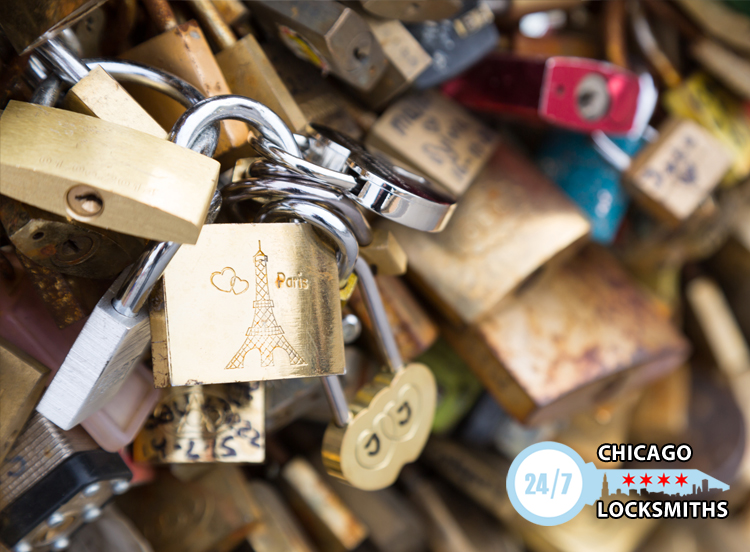Locks are a matter of ancient history – they have existed for thousands of years, since the beginning of society. As history has progressed, the structure and construction of locks have changed. The invention of the padlock was one of the most influential changes in the evolution of locks. The important idea at the center of padlocks is the invention of a lock that can be added and removed from a separate device. Padlocks are simply detachable locks that can be secured with a shackle – which is put on a hinge or springed slide. In this brief blog post I’ll underline some of the important history and etymology of padlocks.
The Etymology of the word ‘Padlock’
Some theories imply that the prefix ‘pad’ means gate, with the implication that padlocks were originally made for locking gates. The prefix ‘pad’ could also imply foot traffic, or walking, implying that these locks were originally crafted to guard gates that led to paths. In the United Kingdom the term ‘Pad’ is also associated with ‘panniers’, baskets used with animals. This implies that perhaps the term padlock originated to describe the locks that merchants would place on bags of their wares that they would attach to animals to carry. The last theory asserts that the term came from Vikings in an English settlement who would use these locks to keep their livestock secure inside containers known as paddocks.
Ancient Rome
The most ancient padlocks currently on record date to 500 BCE, in the Roman empire. This artifact has around body made of iron, with a bolt that can be moved with a key. Many other Roman padlocks are made of two parts with a rectangle body, with a separate shackle and V shaped spring – the two far corners of the ‘V’ are pinched in order to allow the shackle to move. This construction is rudimentary but effective.
Evolution along the Silk Road
As trade routes between Europe and Asia were established, the use of locks became much more widespread as they were enlisted by merchants. By the year 25, the Chinese Empire had implemented massive use of padlocks – these often made of bronze. A few hundred years later in the English province of York, Viking settlements used padlocks to protect their livestock. Leading archeologists argue that these locks were made between the years 850 and 1000 – and as I mentioned before, were used on animal paddocks. The viking padlocks are structurally similar to the Roman padlocks however the Viking ones used flat keys, rather than the “L” bent Roman ones.
Mid-Millennium England
The most drastic changes to the structure of the padlock happened as they became more widely used in England. This evolution was spearheaded, funnily enough, by the use of smokehouses to preserve food. Before refrigerators, citizens needed methods of preserving food for long harsh winters. Smoking meat and fish became a method of rendering food much more impervious to the elements – and as food was in high demand, smokehouses would have to be locked to prevent the food from being stolen. These padlocks were made of wrought iron, and had custom keyways – warded with notches that matched keys. These padlocks however widely disseminated, had structural issues – they could be forced into, and it would be incredibly difficult to figure out if the lock had been picked.
Eastern Europe
In Eastern Europe – in Slavic areas like Russia, Poland, Czechoslovakia, etc..) the advent of the screw key padlock provided an alternative to the smokehouse padlock. This cylindrical key has to be twisted into the lock, and if it aligned properly it could be taken out without having to turn it the opposite way, at the same time stretching an internal spring which would retract the bolt. By around 1910 both screw key locks and smokehouse locks stopped being as popular.
1800s Scandinavia
Invented by the Swedish inventor Christopher Polhem, the Scandinavian lock consisted of a series of rotating disks with side grooves that would match with a certain key – additionally grooves on the outside of the disks had to align in order to release the shackle. Created in the 1870s, these locks continued to be manufactured until around the 1950s.
Also invented in Scandinavia, Cast Heart padlocks, made of brass or bronze, were made with a keyway drop, to protect it from being impacted with particulate matter, and could be easily carried. They were widely manufactured due to their usefulness in incredibly cold or icy climates.
Industrial Revolution and Advent of Electricity
During the 1870s, the Cast Heart lock became widely replicated with cheap materials. Many businesses began using the cheaper locks, even if they were less effective. During this time period, Yale was creating the first padlock that was made of modular components that could be replaced – allowing for rekeying. As electricity came to use, manufacturing of solid metal locks became cheaper and easier – and modular locks became a trend on an industrial level. Shrouds that cover the shackles also came to use.
MasterLock
In the 1920s the Master Lock company released their tumbler and pin based padlock -and manufactured them in droves. The simplification of cast dieing processes made it a possibility for companies to manufacture locks with ornate molds and designs – however due to this embellishment causing functional issues, this trend has mostly disappeared. However, padlocks have become ubiquitous – to the point of becoming a universal symbol of security. Even if new designs of more useful or efficient locks are made in the future, the impact of the padlock will live on in semiotics.

